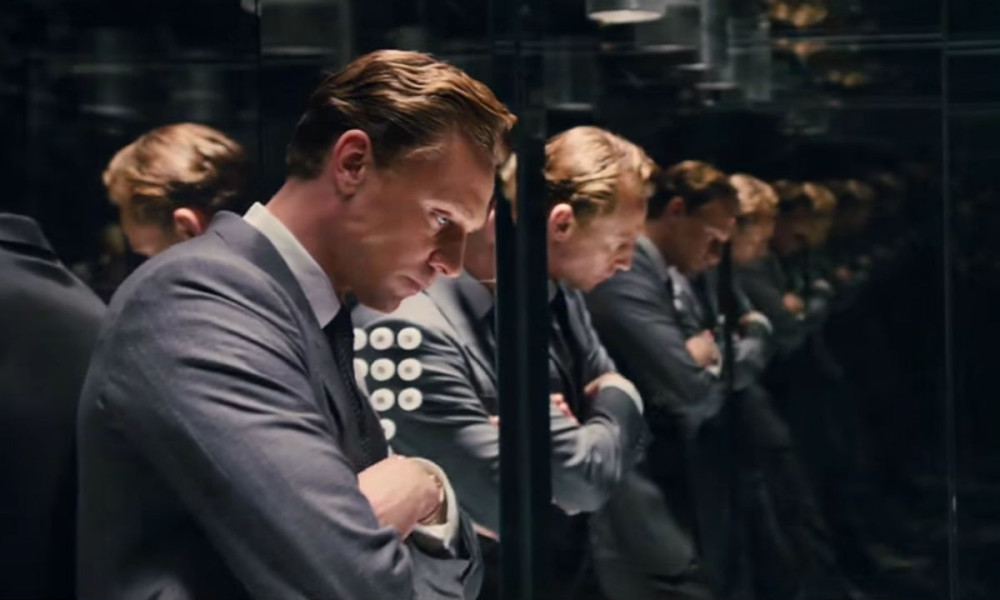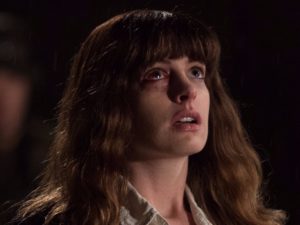
Early on in High-Rise, Dr. Robert Laing (Tom Hiddleston) demonstrates the dissection of a human skull by tearing the face off of a severed head. This being a Ben Wheatley movie, we see the moment in glorious detail: flesh, muscle and tendons are ripped away messily revealing the meat-caked cranium smiling beneath. Just before one of his students faints from nausea, Laing coolly explains “The facial mask simply slips off the skull”. In a film loaded floor-to-ceiling with extreme ideas, this scene distills the film down to one key image. By the end of High-Rise, all exterior facades–facial masks included –are abandoned in favor of ugliness and lunacy.
Whether you’re familiar with J.G. Ballard’s source novel or not, it’s clear from the get-go that life in High-Rise is not going to go smoothly. We first find Laing in a state of total disarray, casually cooking a dismembered Alsatian on a makeshift spit in his squalid apartment. The film then jumps back three months earlier to Laing’s arrival at the high-rise; a luxurious tower block which houses hundreds of apartments, a supermarket and gymnasium and is designed to be completely self-sufficient. It is 1975 and most of the apartments are filled. But already the electricity is starting to fail and elevators are breaking down. It doesn’t take long for the relationships between the upper and lower floors to follow suit.
Perhaps the most surprising thing about High-Rise is how quickly things regress into violence and debauchery. Wheatley and screenwriter Amy Jump aren’t interested in slow-burn storytelling and, in keeping with Ballard’s novel, let things get out of hand pretty sharpish. Before all that though, we meet Laing’s neighbors: a sultry single mother (Sienna Miller) who immediately takes a liking to Laing, and the brutish Richard Wilder and his pregnant wife Helen (Elisabeth Moss) The high-rise is also home to more eccentric characters such as a crazed dentist obsessed with the garbage chute (Reece Shearsmith), the TV actress who parades around the supermarket behind dark sunglasses hoping to be recognized and the building’s architect Royal (Jeremy Iron), a scarred, regal figure occupying the building’s penthouse like an overlord with his aloof wife.
In contrast to many of his supporting players, Laing lacks flavor and distinction. As the film’s protagonist Hiddleston adopts the role of straight man, sharing scenes with characters far more bizarre and interesting than he is. At one point Laing says of his new home: “I was rather expecting to find a certain anonymity here” Well, being that for much of the film’s running time he the least memorable thing in it, I’d say Laing found what we was looking for. This isn’t a problem with Hiddleston’s performance–he’s always watchable–but rather the character itself. As the film becomes increasingly hectic, I became frustrated with Wheatley and Jump’s insistence at keeping Laing front and center. I would have happily let him fall aside if it meant deepening the other characters. A romantic subplot between Laing and Helen Wilder also feels unwarranted. This development is missing from Ballard’s novel and I wonder what Jump’s motivation was for inventing it. Perhaps she felt that with so much deranged madness occurring, seeing two characters connect amidst the chaos would make it easier to digest, or maybe even more tragic? I am not sure.
Most of the film’s early sequences are dedicated to the high-rise itself, letting us take in the space as a feat of production design. Both slick and claustrophobic, it’s a perfect approximation of what the future looked like from the vantage point of 70s Britain. In daylight the apartments look open and hopeful but as night descends the same spaces become shadier and the corridors outside more oppressive. There is a slight disconnect however, between the gloriously physical sets of the high-rise’s interior and the CGI assisted exterior shots intended to add extra scale. As a result, the sheer grandeur of the building’s inner workings never come into real focus nor does the geography of all the floors in relation to one another. I couldn’t tell you how many floors sit between Laing and Wilder, or Laing and Royal for that matter. It’s not essential to understanding the film by any means but more clarity would certainly lessen the unwanted confusion felt during the film’s later sequences. When Wilder sets himself the mission of getting to the top floor, we don’t really know how big or small a task that is. When scenes intercut between apartments we wonder if the proximity between characters is important to their discussion. I have no doubt that Wheatley intends High-Rise to be a disorientating experience but it frequently becomes alienating to the point where you disengage with it entirely.
Showcasing his biggest budget to date and featuring a lavish cast of A-Listers it’s easy to see High-Rise as Wheatley’s grasp at reaching a bigger audience. By choosing to adapt such a challenging novel though, any notions of him “selling out” are immediately dispelled. This is a Ben Wheatley movie through and through. In the few years since Kill List, his visual style has become more assured and as a composer of images he is one of the best currently working. Like his fellow countrymen, Ken Russell and Nicolas Roeg, Wheatley is not afraid of psychedelic cutting and provocative imagery. High-Rise is full of striking visuals: that peeling of the skull at the beginning, a poor soul falling to his death in super slow-motion, a flickering television set lying amidst a sea of garbage — all of this accompanied by Clint Mansell’s brilliant score (which also includes an inspired Portishead cover of ABBA’s “SOS”). The building’s initial descent into madness is also thrilling in its brute force. As the tenants become more primitive and their surroundings more grimy you can feel the horror of that environment. The film reaches visceral heights in these moments and for a time, it’s very effective. But slowly any semblance of plot or clarity gives way to repetitive sequences of cluttered frames.
While this is a film inherently about extremities and excess, the film loses shape and drive in its endless depictions of that excess. At its worst, Wheatley’s penchant for raw shocks and vulgarity feels juvenile. By the time Royal’s wife asks a roomful of men mid-orgy: “Which one of you bastards is going to fuck me up the arse?”–a line clearly played for belly-laughs–you find yourself checking your watch wondering when all of this is going to amount to something. High-Rise is a bold film painted with bold strokes. There’s a lot of ideas at work here, an ambition and vision that reaches beyond anything Wheatley and Jump have attempted before and I am glad for that ambition. It’s great to get movies like this that aim to challenge and provoke us, even when their reach exceeds their grasp,.
I have seen High-Rise twice now and the second viewing was greatly enhanced by reading Ballard’s novel in the interim. The film never explicitly goes into why the tenants devolve into mindless mobs but Ballard suggests there is some kind of unspoken group psychosis that occurs when human beings are packed like sardines in such a vast concrete chamber. In their savagery the tenants find unity and agreement that slowly tears them apart. High-Rise: the movie is not like that. This is a film that will frustrate and divide audiences with its shortcomings, ambiguity and explicit dashings but will also bring them together with intelligent discussion. It is not my favourite Ben Wheatley film but it’s certainly the one I have thought the most about.
—
Directed by Ben Wheatley; written by Amy Jump; based on the novel by J.G. Ballard; starring Tom Hiddleston, Sienna Miller, Luke Evans, Jeremy Irons, Elizabeth Moss, Reece Shearsmith, James Purefoy; 119 minutes.
High-Rise is available on all VOD platforms from April 28th and will be in limited release from May 13th.



 Derek
Derek
 Isabelle
Isabelle